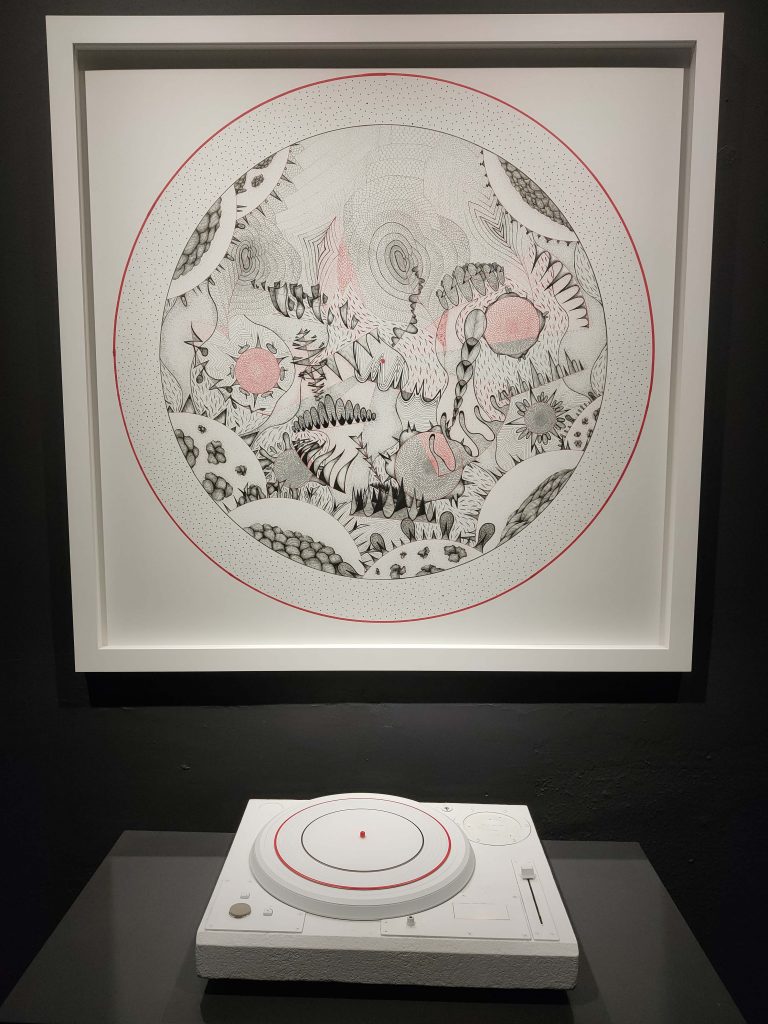Work, their background, answering what you discovered that gave you more insight about the artist’s concerns and working methods.
ESCAPE VELOCITY III & IV
by ZAI TANG

Even though I did not attend the whole exhibition today, the work that caught my eye the most today was the first work I observed when I reached Gillman Barracks earlier than the meeting time.
Zai Tang’s Escape Velocity III and IV.


At first, I did not understand the whole concept but I realized that you have to sit there for quite a while in order to absorb the piece, through listening to the nature of the sounds and the tempo of the visuals. In fact, the longer I sat there, the more immersed I was into relating the artistic patterns to the sounds that were playing at the same time.

In Escape Velocity III, Zai Tang focuses on the difference between nature and synthetic, highlighting the tension between nature and capital. There is a delicate balance struck between the two, in a world that is slowly being devoured by concrete blocks. Tang uses slowed down field recordings of wildlife from places under threat by development and plays it against abstract art. The two art pieces incorporates sounds from Mandai, which is an area undergoing development into an eco-tourism destination.
I think that it is very interesting how Tang plays around with colour and the type of drawings to express the difference between smooth natural surroundings and the more jagged, rigid concrete jungle we live in. The sounds are also modified to expressed such, alongside the different vinyl players; the black vinyl player portrays a recording that will wear out over time, just like the nature around us when it deteriorates slowly. The white vinyl payer, on the other hand, is automated and does not wear out as it merely plays a recording. This is the synthetic nature of our concrete jungle, where it will never rot but will never be natural as well. I also think that it is very smart to make use of an analogue sound system to highlight the idea of sound, juxtaposed against a still image. This gives more room for the viewers to imagine how the portrait should tell its story, based on the sounds that accompany it.
While Escape Velocity III is more on a critical commentary about how nature is dying, Escape Velocity IV is about how we should conserve the nature.

Escape Velocity IV, on the other hand, focuses more on the visualisation of nature through sounds and abstract artistic shapes. I think that this piece is very unique because it does not really show any literal nature imagery unlike Escape Velocity III which does. However, I think what struck out to me the most as an ecological conservation art piece is how the nature is being preserved through this abstract visualization of nature sounds. It is quite sad in all honesty, but it is a way of preserving the nature that will soon die out if no one does anything about our planet earth.
If we take the artist’s background into account, I think he feels this more strongly especially since UK and Singapore are both countries that invest a lot in buildings rather than greenery and natural preservation. Also, when we observe the placement of the exhibition, we can see that Escape Velocity III is placed outside the room containing Escape Velocity IV. This plays up the idea Tang tries to convey, which is to first show us the dirty reality of how our ecosystem is dying, following by his presentation of conservation efforts we should be doing to preserve the ecosystem. Especially when these exhibitions are separated into two segments, I think it creates a very clear meaning about the purpose of the exhibition.

